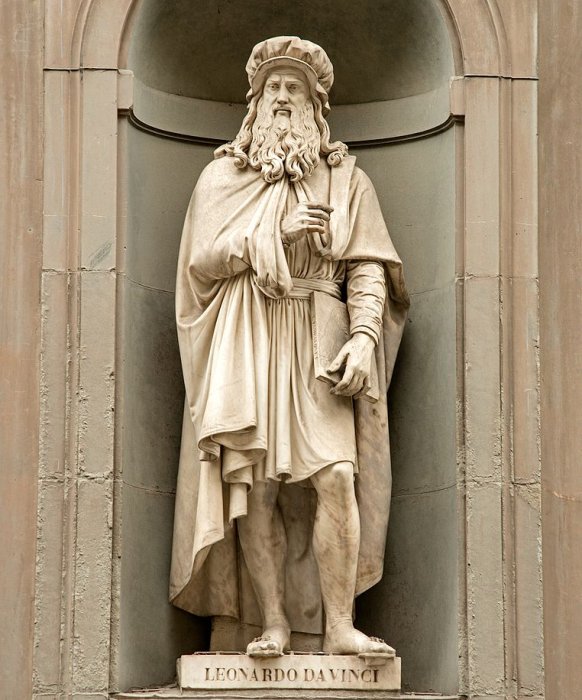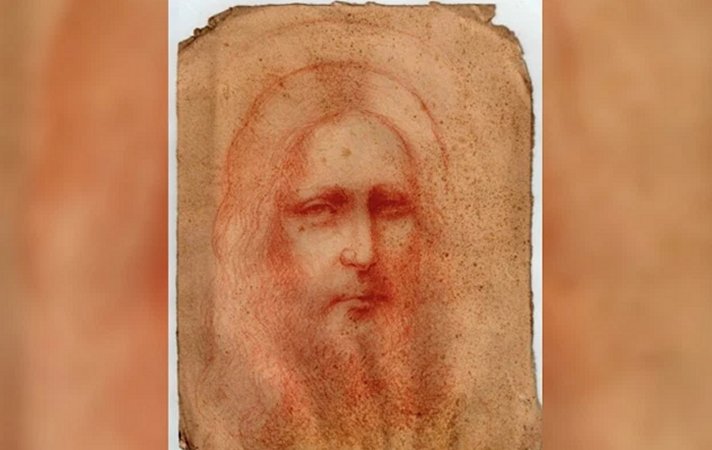Jan Bartek – AncientPages.com – Leonardo Da Vinci (1452 – 1519) was one of the greatest minds of the Renaissance.
His inventions, paintings, and sculptures are today admired by millions, but by now it’s well-known he had many secrets he was unwilling to share with the world.
Scientists have found many hidden figures beneath his famous paintings. Earlier this year, researchers announced there several hidden figures beneath the Virgin of the Rocks, one of his early masterpieces. Scientists also found unknown handprints that may have been Da Vinci’s own.

Statue of Leonardo da Vinci Statue outside the Uffizi, Florence, by Luigi Pampaloni (1791–1847). Credit: Peter K Burian – CC BY-SA 4.0
Sometimes da Vinci painted objects fully visible, but they pose a riddle because we do not know what they represent. The mysterious orb in da Vinci’s Painting Salvator Mundi has intrigued many art historians.
Those who enjoy true art mysteries are fascinated with da Vinci’s lost painting the Battle of Anghiari. Painted in the early 16th century by Leonardo da Vinci, the artwork is lost, but some think it may be hidden beneath later frescoes in the Hall of Five Hundred (Salone dei Cinquecento) in the Palazzo Vecchio, Florence, Italy.
It is one of art history’s greatest mysteries that many are still trying to solve.
Every now and then we hear scientists have discovered an unknown sketch or painting by da Vinci, and it’s always a delight to learn more about the works of this Renaissance genius.
But have scientists really discovered the Holy Grail of art? Hidden for centuries in a private collection at a bank in Lombardy, Italy, a curious sketch has now emerged. According to experts, this previously unknown red-chalk drawing can be a work of Leonardo da Vinci. This has not yet been officially confirmed. Scientists must investigate it further, but tests carried out on the paper on which it was drawn have placed it in the early 16th century.
The sketch has striking similarities to da Vinci’s painting Mona Lisa and “experts say that one thing which suggests it could be Da Vinci’s work is the posture, which is not front on to the viewer but on an angle,” Euro Weekly reports.
But why are so many now excited about this particular sketch? The big story behind this previously unknown masterpiece it’s very likely da Vinci made a chalk drawing of Jesus Christ.

This previously unknown sketch may have been made by da Vinci and could depict Jesus Christ. Credit: Leonardo da Vinci International
“It is a remarkably beautiful and refined work and I’m absolutely convinced it is a sketch by Leonardo,” Annalisa Di Maria, an Italian art historian who studied the sketch, told the Telegraph.
“There are lots of elements — the posture of Christ is typical of Leonardo, who rarely drew figures front-on but from an angle,” said Di Maria. “It has that dynamism and sense of movement that is typical of Leonardo.”
She added, “The rendering of the beard is practically identical to Leonardo’s self-portraits, as are the eyes. And the painting is in red chalk, which the artist used a lot, including in the sketches for The Last Supper.”
Martin Kemp, emeritus professor in the history of art at Oxford University doesn’t want to dray any premature conclusions adding it’s important to find out if the sketch is drawn left-handed. Leonardo drew everything with his left hand.
If scientists can confirm this is a new, previously unknown masterpiece by Leonardo da Vinci, then we do have a reason to say it’s could be the Holy Grail of art.
Written by Jan Bartek – AncientPages.com Staff Writer





